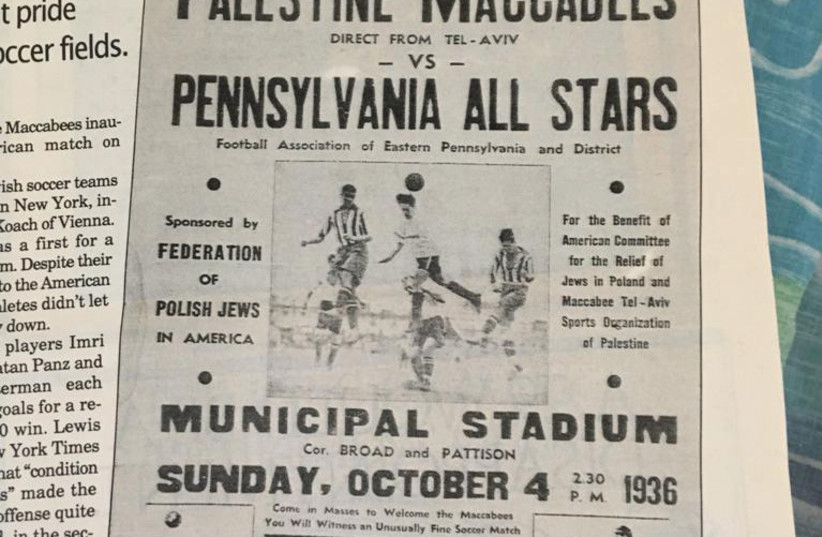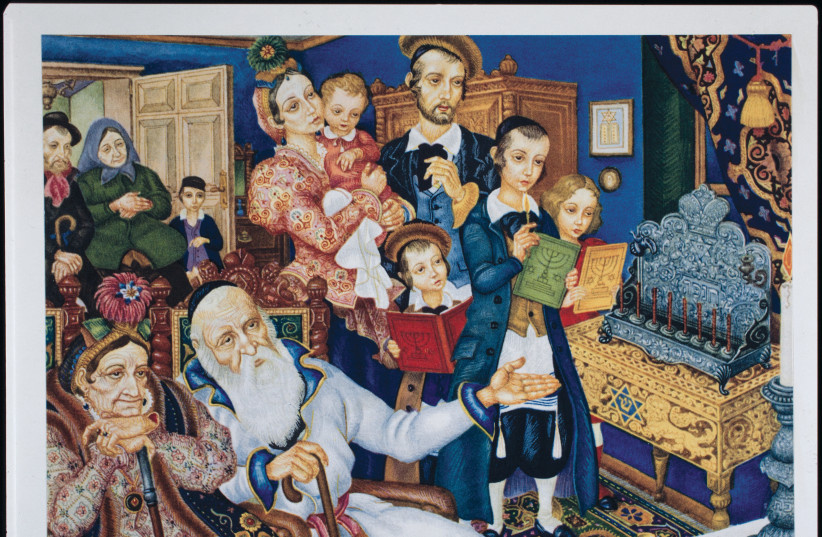Living in Israel, you naturally can experience the sites, the battles and triumphs that are the basis of the Hanukkah celebration.
Judah Maccabee, his father and his brothers are individuals who continue to provide us with that fighting spirit. Throughout my lifetime, it has occurred to me on numerous occasions, I actually feel pushed to ensure victories for myself – inspired by the Maccabees.
Irvin Ungar, the noted American bibliophile, has used his collection talents and perseverance over more than two decades to discover the original art of Arthur Szyk. He has used the image of Judah Maccabee in new formats to make us all more cognizant of the dynamism and many dimensions of the powerful images of the Hanukkah hero himself.
For the year 5718, Ungar designed a calendar entitled “The Heroes of Ancient Israel.” He sent me a copy, and I treasure it because I have been a Szyk fan since my teenage years. To be honest, my scope was limited. I was introduced to his art in Pathways Through the Bible; the wonderful Aron Kodesh at the Forest Hills Jewish Center in Queens, and the colorful Declaration of Independence of Israel, the most copied and distributed of his work.
In the 1990s, when I was a rabbi at Temple Israel in Scranton, Pennsylvania, Ungar approached me about encouraging a Szyk exhibit at the University of Scranton, a Jesuit institution. I am proud to say that the exhibit was held for over a month, with 500 visitors. Ungar’s informative and charismatic address about Szyk was covered in the local newspapers, the Jewish Community Center monthly, and the bulletins of all the local synagogues. For me personally, it opened my eyes to the wide extent and potency of the Syzk oeuvre.
As important for Judah Maccabee and other noted ancient figures created by Szyk, Ungar reissued the playing cards of “heroes” that Szyk designed in the 1930s. My late wife, Rita, and I played with the cards at the home where she lived for the last five years of her life, and the staff and visitors asked about them frequently.
For publication this year, Ungar provided me with Judah Maccabee and other images of the holiday.
Because the Maccabees had an impact on Christians and Jews in the last two centuries, that name is found in different venues. Here in Israel an early soccer team was titled the Palestine Maccabees. In 1936 those “Modern-Day Maccabees” played a series of games in the United States against local teams. Yes, soccer was an American sport over 90 years ago.
I researched and wrote about those games as a tribute to the Olympics in 1996 in my hometown of Atlanta.
The Federation of Polish Jews in America sponsored the team’s visit. Der Tag, a daily Yiddish paper in the United States, covered the first game: “The enthusiasm of the crowd was amazing. Cheering the Palestinian soccer team were thousands of fans who crowded Yankee Stadium.”
Yes, Yankee Stadium.
“Every goal brought those present to their feet as they shouted loudly: ‘Maccabee’ What pride everyone felt in this triumph.”
The Maccabees won that game, showing the world how far sports had progressed in Palestine. Jews who streamed to their homeland during the British Mandate period were not only developing agricultural, industrial and research skills, but athletic abilities. The Yiddish paper explained additional background on why that visit was so significant.
“Despite Adolf Hitler’s attempts to keep Jews from the Olympics in Munich in 1936, the Palestinian Jews were determined to demonstrate their sportsmanship,” Der Tag wrote. Historians have suggested that it was the triumphant spirit and the soccer team’s world-class recognition that eventually led to the formation of today’s Israeli Olympic movement.
September 1936 was a great month for the Jews of the United States. David Dubinsky, head of the International Ladies Garment Workers Union, personally solicited support for the team’s visit.
“When the Palestine team of 11 athletes landed in New York, The New York Times focused on the fine conditioning of the players, their training for the American tour, and athletic prowess. A few days later, the team was welcomed at New York City Hall by Mayor Fiorello La Guardia.”
The mayor was at Yankee Stadium to kick off the first ball in the Palestine Maccabees inaugural American match on September 27. The local team was made up of players from various cities in the northeastern sector of the United States.
Hakoah Vienna had come to the USA and played in New York. However, this was a first for a Palestine team. There is a description of that first game.
“Maccabee players Imri Mausner, Natan Panz and Illiya Westerman each scored two goals for a resounding 6-0 win.”
Lewis Funke of the Times drew these conclusions about the Palestinian team:
“Condition and deftness made the Maccabees offense quite smooth. In the second half of the game, the Maccabees clicked with splendid combination play that swept the opposition.” Concluded Funke: “The Maccabee squad had brought an exciting style of play to the American shores.”
After New York, the team’s second match was against the Pennsylvania All-Stars at Municipal Stadium in Philadelphia, with 30,000 people attending on October 4. That game cannot be forgotten because the poster for that match was found by Peter Schweitzer, noted collector of American Jewish memorabilia. Mayor S. Davis Miller attended.
Once again the Maccabee team triumphed 1-0 for its 27th consecutive victory.
On this Hanukkah, let us recall that triumphant event in Palestine-Israeli sports history.
The first journal of the Federation of American Zionists was entitled, “The Maccabeean.” Jacob De Haas, a close friend of Herzl, came to the United States in 1902 to be the editor of the new monthly. Fortunately, the National Library in Jerusalem has most of the issues of the Maccabeean. The monthly was unique because it contained stories not covered in the Yiddish press of that era.
I was given the opportunity by Amnon Hadary, the late editor of the Forum magazine, to publish the “Diary of Jacob de Haas’s trip in 1904” when he described “Early Zionist Activities in the South.” The editor entitled the article “A Sentimental Journey.” De Haas traveled through the states of Virginia, South Carolina, Georgia, Alabama, Louisiana, and Texas. Out on the range, he saw a “Zionist on horseback.”
There were Jewish and Christian secret Maccabeean societies. Judah Maccabee and his brothers have left an impact both for their fighting abilities and also for the organizations and publications named for them. Finally, I sang the oratorio “Judas Maccabeus” with the Emory Glee Club during my college years. All hail to Judah and his Maccabee brothers!


